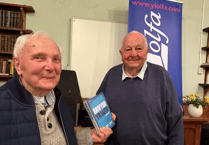A nature reserve near Machynlleth has made a startling reversal of an endangered species thanks to an unlikely herd of ancient cattle.
Visitors to RSPB Ynys-hir may be surprised to see a herd of beautiful cows grazing in the nature reserves delicate forests, saltmarsh and estuary, however they have been put there to do precisely that.
In the three years since Helen Upson’s herd arrived at the site, the number of endangered European Pied Flycatchers has doubled.
But how has a herd of rare Ancient Cattle of Wales achieved such an amazing feat?

The delicate ecosystems that needed protecting 50 years ago with fences to keep out destructive species now need a different type of care.
Conservation grazing is an increasingly used technique to improve habitats for wildlife by using livestock to create varying levels of vegetation and bare ground, allowing rarer plant species to thrive.
Many nature reserves have adopted this method as an effective approach to improve biodiversity.
Helen, a conservation expert, said: “We’re returning grazing animals to woodlands to replicate herbivores moving through the landscape as they will have done in the wild hundreds of years ago.
“This introduces disturbance to make space for smaller and rarer plants.”

Helen was already working for RSPB Ynys-hir on a celtic rainforest project when she noticed the potential for her herd, named Pori Bach.
The ponies which were being used for conservation weren’t eating the vegetation that needed grazing and were becoming hungry.
After management agreed to a trial, the Pori Bach herd became “a roaring success”, eating the vegetation other species wouldn’t, and contributing to a doubling of the number of Flycatcher nests.
Flycatchers are an endangered species, their numbers declining by 59 per cent between 1997 and 2022.

David Anning, Site Manager at RSPB Ynys-hir, said: “Pori Bach cows have transformed our management at Ynys-hir.
“They have contributed to the conservation of one of our most endangered birds, the Pied Flycatcher, a species that’s on the Amber list in the Birds of Conservation Concern in Wales assessment.
“Wales holds over half of the UK population, so it’s vital that we do all we can to maintain a healthy population at Ynys-hir.
“Pied Flycatchers prefer open woodlands, and the Pori Bach cows have done an excellent job at opening up areas of overgrown woods at Ynys-hir.
“Our Pied Flycatcher population is now stable, which is good news considering that it is set against a backdrop of a long-term decline elsewhere.”
Helen’s herd isn’t just doing this in Ynys-hir.
By clearing away dominant vegetation like brambles, rushes or ivy which can take over space and cast shade against the floor, the cows are creating more space and light for rarer plant species.
In Llanymynech on the Shropshire border, her herd is bringing back violets which grow on the edges of bracken - the return of the violets contributing to the return of the “very rare” pearl-bordered fritillary butterfly.
By eating ivy which if left can dominate woodlands, the cows make space for lichens which would otherwise be easily strangled by the ivy.
But her herd isn’t any type of cattle, they’re unique too.
After using Scottish Highland Cattle for conservation efforts in Wales, Helen was challenged by a farmer to use Welsh cows for the job.
The Ancient Cattle of Wales is a rare minority species, a cousin to the famous Welsh Black breed, with only 300 purebreds in existence.
The cows are hardy, self-sufficient and tough enough to withstand the weather on rough terrain with steep hillsides.

David Anning said: “Traditional native breeds are naturally very hardy, and they’re excellent at eating vegetation that other animals will not touch.
“Ynys-hir is a nature reserve which is open to the public, so we also need grazing animals that are calm around people.
“These cows are excellent as they are confident near people and generally keep themselves to themselves.”
Helen is now the vice chair of the Ancient Cattle of Wales Breed Society and is trying to save the rare breed by gaining government recognition as a native rare breed.
If you own this breed, get in touch with her at https://ancientcattleofwales.org/contact/
To learn more about conservation grazing, attend Helen’s talk at the Wales Real Food and Farming Conference 20-22 November in Lampeter.





Comments
This article has no comments yet. Be the first to leave a comment.